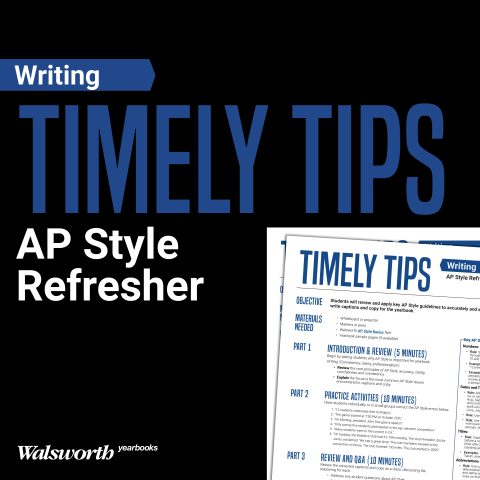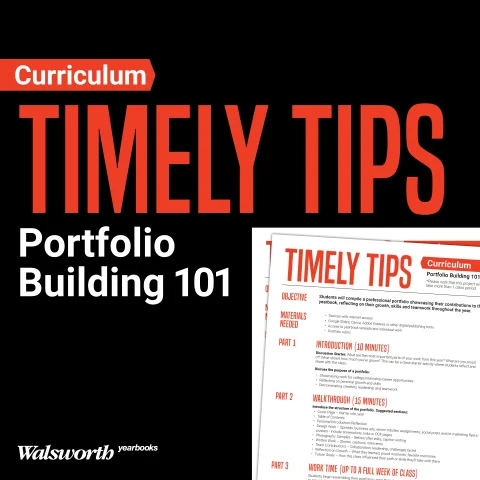Yearbook season is a whirlwind of creativity, deadlines and capturing memories that last a lifetime. But amidst the excitement, one crucial element often gets overlooked: consistent, professional writing. That’s where AP Style comes in, and mastering it is essential for producing a yearbook that shines. Our latest Timely Tips lesson plan covers this very topic.
Why does AP Style matter for your yearbook? Simply put, it ensures accuracy, clarity and consistency. Think of it as the grammar and usage bible for journalists and writers, providing a standardized approach to everything from numbers and dates to titles and quotations. For yearbook creators, adhering to AP Style elevates your work from a collection of snapshots to a polished, professional publication.
Let’s break down some of the most common AP Style points that yearbook teams encounter, and how to avoid those pesky errors. We also have a downloadable AP Style Basics cheat sheet with even more rules that you can provide for your students for easy reference when editing.
NUMBERS: SPELLING AND FIGURES
One of the most frequent stumbling blocks is knowing when to spell out numbers and when to use figures. The golden rule? Spell out numbers one through nine, and use figures for 10 and above. For example, “three students” versus “12 members.”
However, there are exceptions. Ages, years, percentages, measurements and scores always use figures. So, “15-year-old students,” “the year 2024,” “a 25% increase,” “a 10-foot jump,” and “a score of 50 points” are all correct. Also, if a number begins a sentence, spell it out.
DATES AND TIMES: PRECISION IS KEY
When it comes to dates, abbreviate months with six or more letters (Jan., Feb., Aug., Sept., Oct., Nov., Dec.) when followed by a date. March, April, May, June and July are always spelled out. Use figures for dates and remember the proper format for times: lowercase “a.m.” and “p.m.” with periods (e.g., 2:30 p.m.).
TITLES: CAPITALIZATION AND CLARITY
Titles can be tricky. Capitalize formal titles before a name (e.g., “Principal Smith”), but lowercase them after a name or standing alone (e.g., “Sarah Jones, principal”). This rule ensures clarity and professionalism in your writing.
ABBREVIATIONS AND ACRONYMS: USE SPARINGLY
Common abbreviations like “U.S.” and “Dr.” are acceptable. However, avoid using abbreviations that are not widely understood. If you must use a less common abbreviation or acronym, define it on the first reference. Clarity is paramount.
QUOTATIONS: ACCURACY AND ATTRIBUTION
Quotations add depth and personality to your yearbook. But they must be handled with care. Place periods and commas inside quotation marks, and always attribute quotes accurately. Use “said” as your go-to verb for attributing quotes, rather than more dramatic verbs like “exclaimed” or “yelled.”
PUTTING IT INTO PRACTICE: COMMON ERRORS AND CORRECTIONS
Let’s look at some common errors and how to correct them, just like the students in the Timely Tips lesson plan did:
- Incorrect: “12 students celebrated their birthday’s.”
- Correct: “Twelve students celebrated their birthdays.” (Spell out “twelve” and correct the possessive.)
- Incorrect: “The game started at 7:30 PM on October 25th.”
- Correct: “The game started at 7:30 p.m. on Oct. 25.” (Lowercase “p.m.” and abbreviate “October.”)
- Incorrect: “On Monday, president John Doe gave a speech.”
- Correct: “On Monday, President John Doe gave a speech.” (Capitalize “President” before the name.)
- Incorrect: “Only twenty-five students participated in the Apr. eleventh competition.”
- Correct: “Only 25 students participated in the April 11 competition.” (Use figures for “25” and spell out “April.”)
- Incorrect: “Many students went to the concert in CA.”
- Correct: “Many students went to the concert in California.” (Spell out “California.”)
- Incorrect: “On tuesday, the Robotics Club had it’s 10th meeting. The club President, doctor Jones, exclaimed, ‘We had a great time!’ The club members traveled to the convention in Illinois. The club traveled 150 miles. The club started in 2005.”
- Correct: “On Tuesday, the Robotics Club had its 10th meeting. The club president, Dr. Jones, said, ‘We had a great time.’ The club members traveled to the convention in Illinois. The club traveled 150 miles. The club started in 2005.” (Capitalize Tuesday, correct it’s to its, lowercase president, capitalize Dr. and use said instead of exclaimed.)
Beyond the Basics: Proofreading and Editing
Even with a solid understanding of AP Style, proofreading and editing are essential. Take the time to carefully review your captions and copy before submitting them for publication. A fresh pair of eyes can catch errors that you might have missed.
Resources and Tools
For a comprehensive guide to AP Style, utilize online AP Style guides and refer to the Walsworth AP Style Basics flyer. These are great resources to have on hand.
By mastering AP Style, you’ll elevate your yearbook from a simple collection of photos to a professional, polished publication that your school will cherish for years to come.





